Imagine a world where the building code does not allow returns to be installed in closets to control mold and other contaminants. That would be insane right? Welcome to the real world.
Let me make the case for closet air change…in cold climates, hot-humid climates and mixed humid climates. Then let’s look at the arguments against code allowed returns. And finally let’s look at a sleazy way to get around the code if the “authority having jurisdiction”….the “local big dog chief building official” does not agree with the argument. Note that the local chief building official has the authority to make exceptions to the code language. A good code official1 who knows stuff is more important to know than a good surgeon. Lots of good surgeons…well there used to be back in the old days…
A classic example of mold occurring in a cold climate closet is that of an exposed closet on an exterior wall (Figure 1). Its heat loss is high and the closet will be colder than the bedroom it is attached to. If the vapor pressure in the bedroom is the same as the vapor pressure in the closet, and the closet is colder, then the relative humidity in the closet will be higher than the relative humidity in the bedroom. If the closet experiences mold, it is apparent that the relative humidity in the closet is greater than 80 percent. However, the key question is this: is the relative humidity above 80 percent because the closet is too cold, or is it because there is too much moisture present (high vapor pressure) in the closet? Is this a surface temperature mold problem, or is this a vapor pressure mold problem – or a combination of the two?
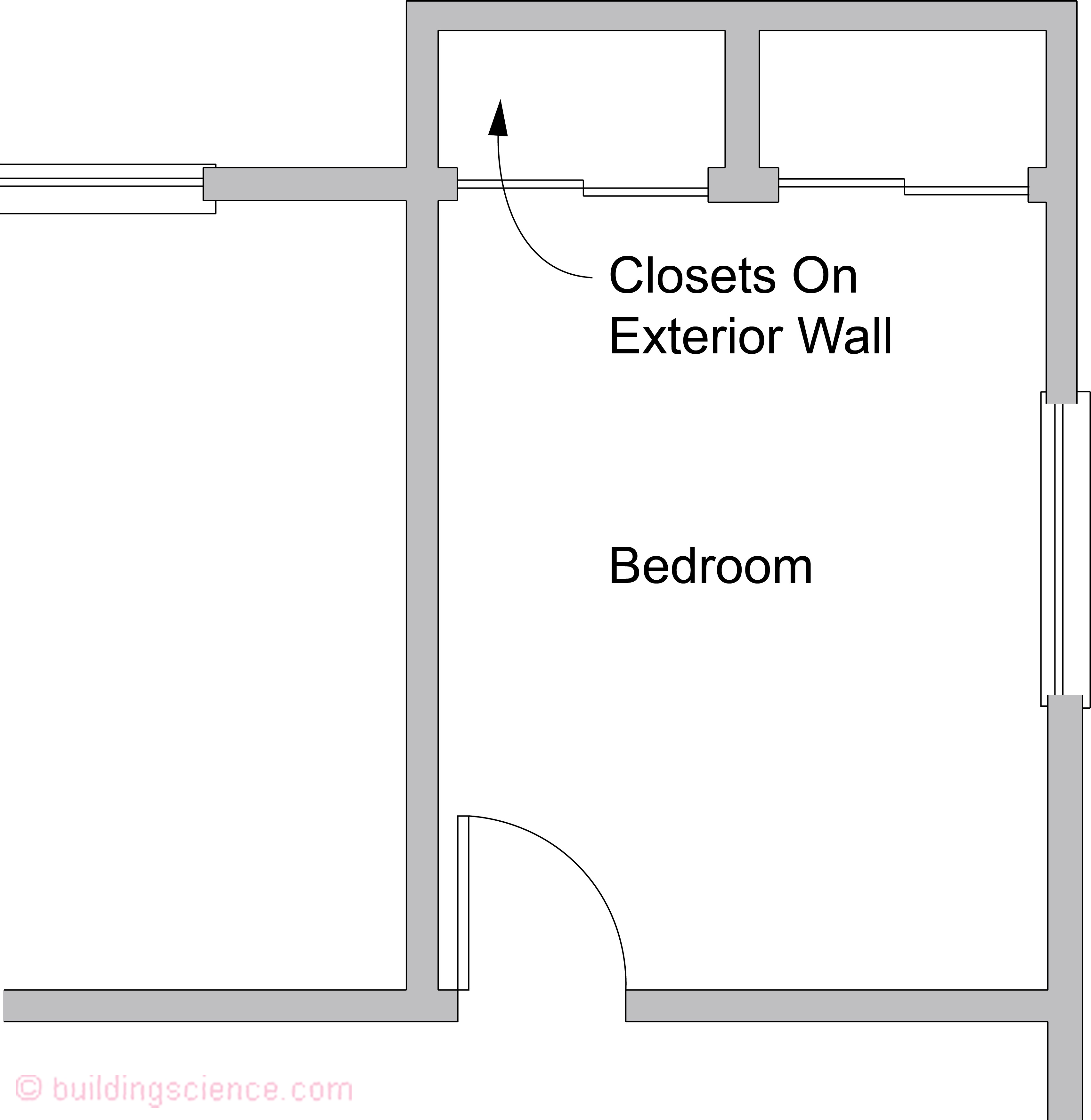
Figure 1: Cold Climate Closet - Its heat loss is high and the closet will be colder than the bedroom it is attached to.
It is usually a combination of the two. Controlled ventilation (air change) in the house will reduce the vapor pressure (and therefore relative humidity) in the house. Yeah! But, folks are now wanting higher interior relative humidity in houses for health reasons (yes, we were here before…BSI-133: Covert Covid Thoughts, July 2022). The temperature of the closet can be increased by increasing the heat flow to the closet or decreasing the heat flow out of the closet to the exterior (more insulation…especially continuous exterior insulation). But what if you can’t do the insulation thing because the house is already up….Increasing the heat flow to the closet can be as simple as replacing the closet door with a louvered door thereby promoting air circulation (Photograph 1). The air circulation will carry heat into the closet, warming the closet and reducing its relative humidity.
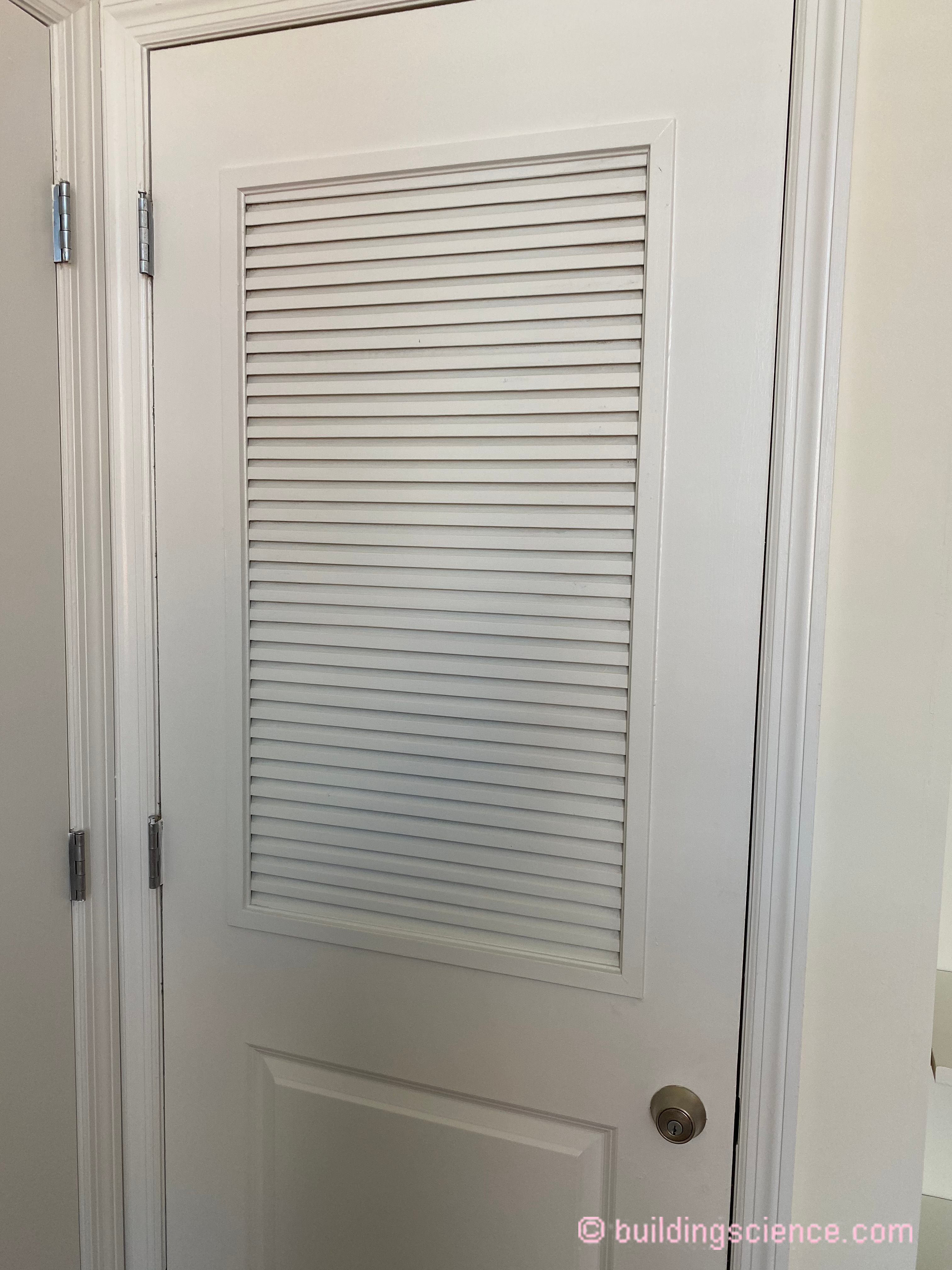
Photograph 1: Louvered Door - The air circulation provided by the louvered door will carry heat into the closet, warming the closet and reducing its relative humidity. Unfortunately, lots of folks do not like the look of louvered doors.
Unfortunately, lots of folks do not like the look of louvered doors. If we could convince everyone that louvered doors were a good idea we would not be having this discussion2. OK, so if I can’t install a louvered door, the air circulation can be improved and the closet heated by installing…wait for it…a return.
A classic example of mold occurring in a hot humid and mixed humid climate is that of a closet located under an insulated ceiling. Insulation levels are going up in all climates including hot humid and mixed humid climates.
What happens when you increase attic insulation from R-30 to R-38? Or to R-49? Wait for it….your ceiling gets colder…. Don’t you just love this? Yup, the attic insulation does its job. The load from the attic is reduced. Now couple this with higher dewpoint temperatures at the underside of the ceiling. Where do the higher dewpoint temperatures come from? Ah, we were here before….a couple of times….part load humidity, higher ventilation rates and way more thermal efficiency (BSI-006: No Good Deed Shall Go Unpunished, July 2016 and BSI-109: How Changing Filters Led To A Condensation And Mold Problem, December 2018).
So what do you get with all this…. the M word again. What spaces have the least load? Closets. Closets are now getting colder in hot humid and mixed humid climates. Closets get moldy (Photograph 2). Closets need “active” returns at the ceilings (Photograph 3) and undercut doors or transfer grilles to equalize the temperature and pressure between the closet and the rest of the house (Photograph 4 and Photograph 5) or both undercut doors and transfer grilles.
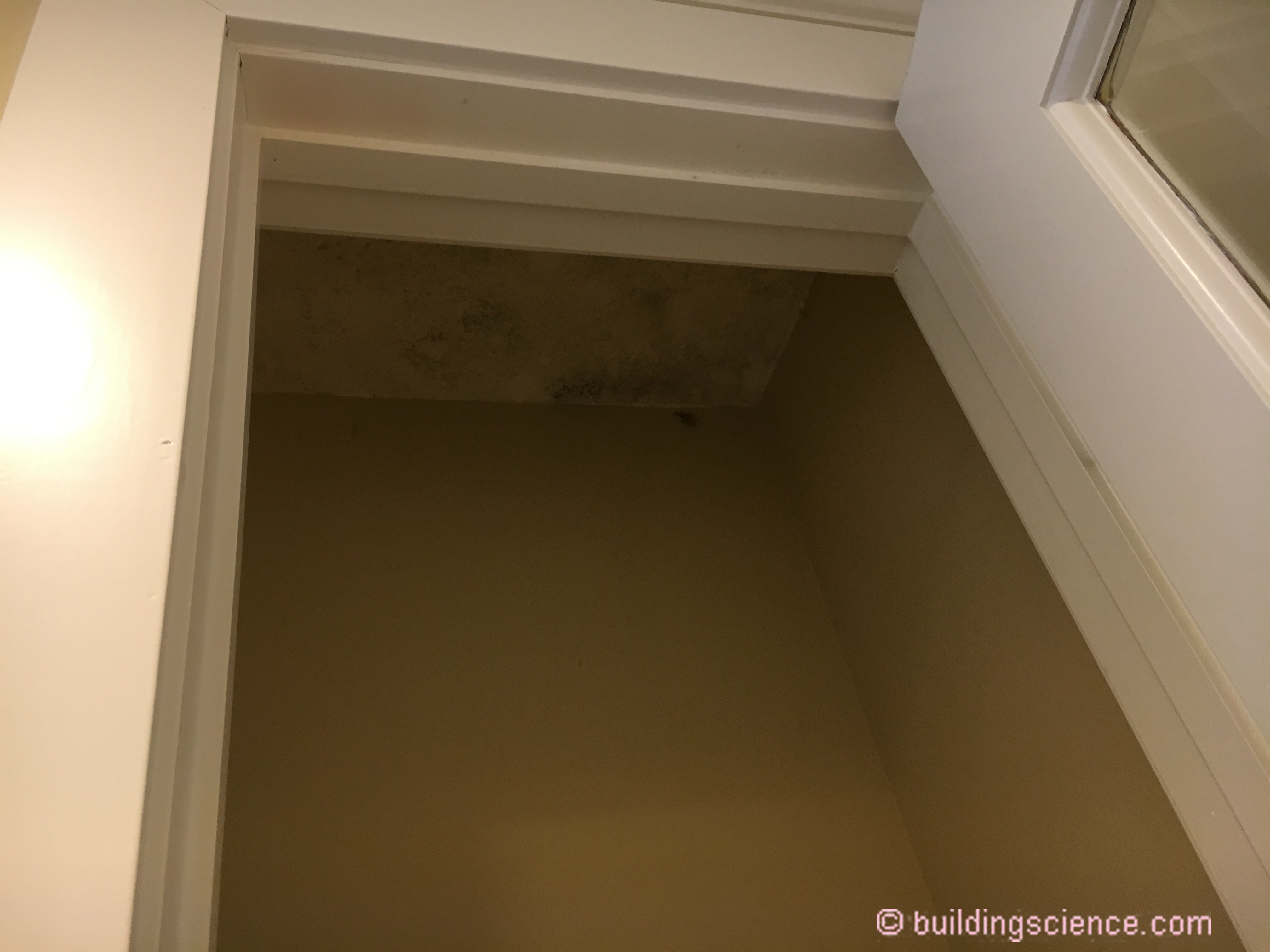
Photograph 2: Mold in Closet - We now get mold inside the home at closet ceilings. When we couple the colder closets with higher levels of ventilation air you need to add supplemental dehumidification or you have to provide closet ventilation or both. Sure would be nice if sales and marketing would let us go back to louvered closet doors.
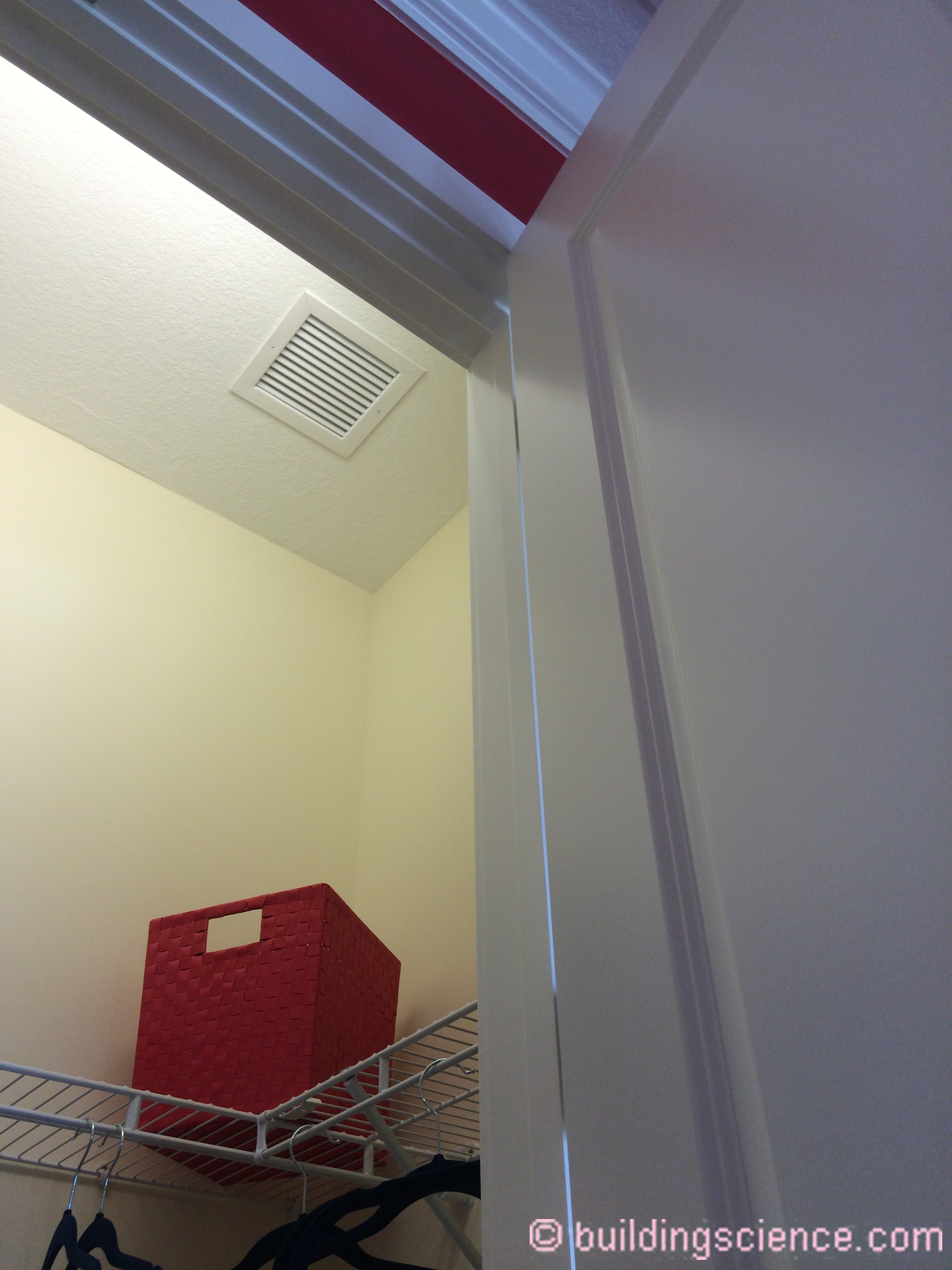
Photograph 3: Closet Ventilation - The best way to provide closet ventilation is to install a small return air duct in the closet.
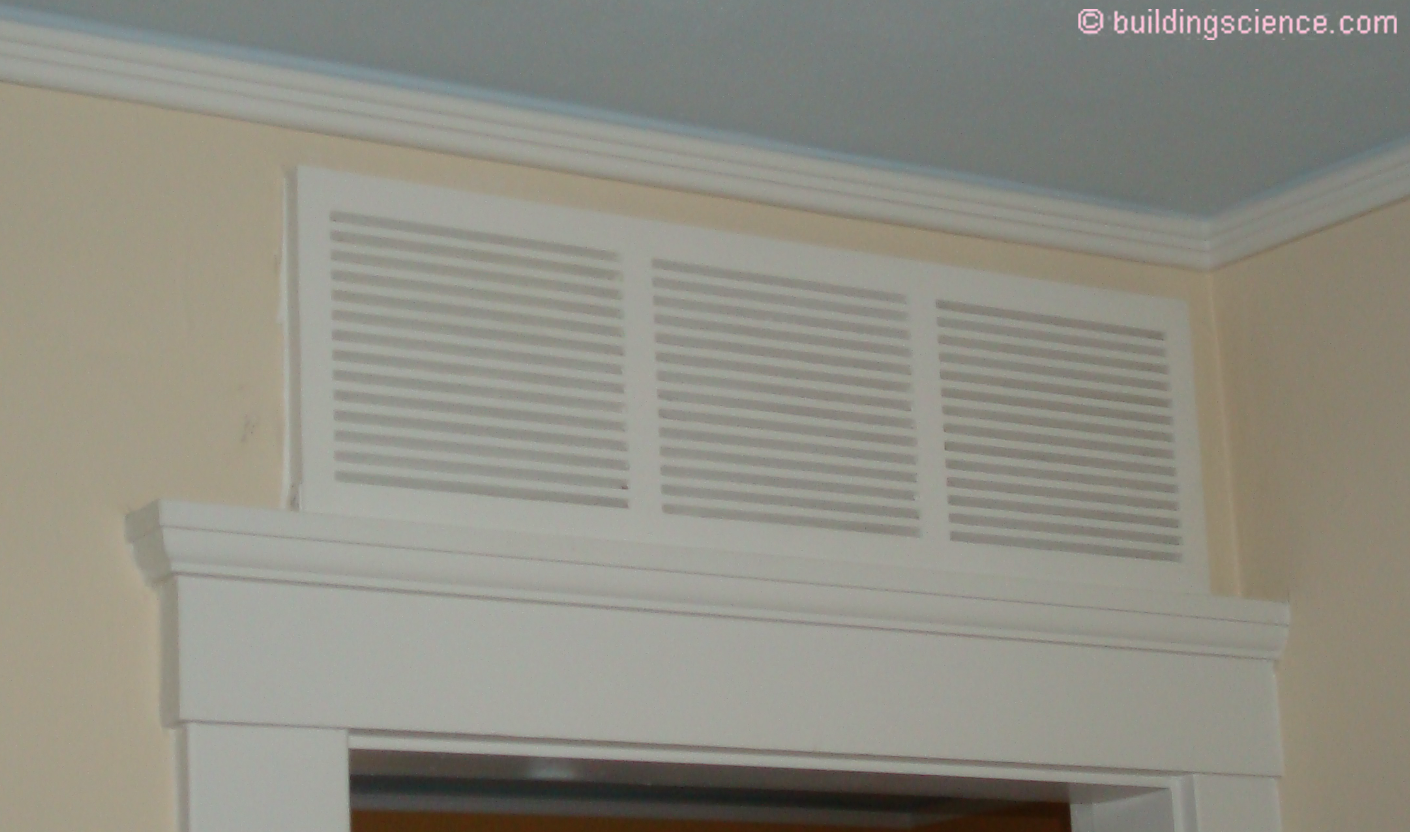
Photograph 4: Transfer Grille – Couple transfer grilles with undercut doors to equalize the temperature and pressure between the closet and the rest of the house.
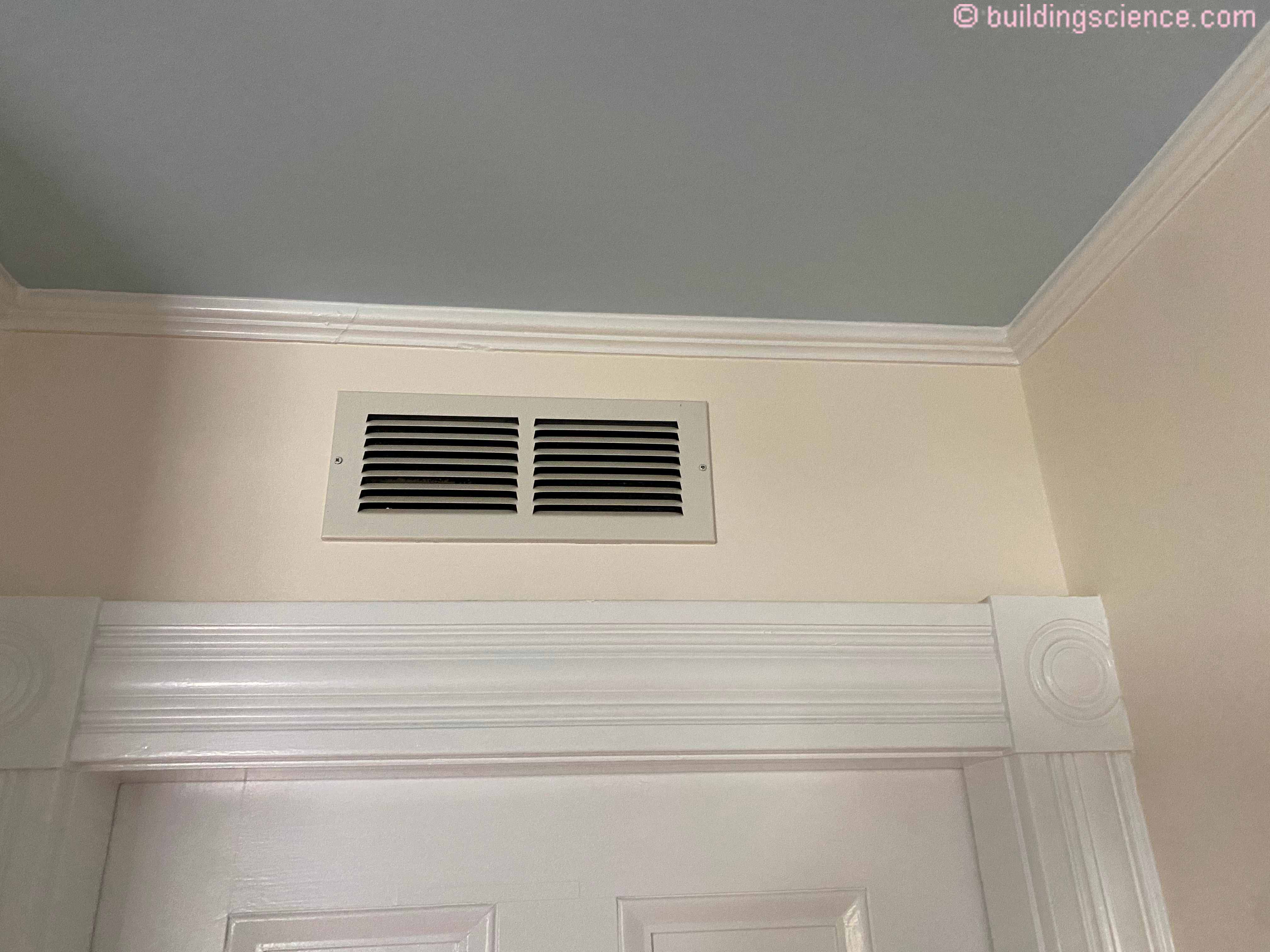
Photograph 5: More Transfer Grille – Don’t forget undercutting the door.
What about just installing transfer grilles and undercut doors and no “active” return? It does not work consistently enough. The approach works in marine climates and mixed dry climates but not consistently enough in hot humid and mixed humid climates. Here is where I point out that louvered doors do work consistently enough…but I don’t win that argument because apparently I have no “taste” or sense of “interior design, look or style”. It is tough being an engineer3.
There is another huge, huge reason to “ventilate” closets. They are filled with things that are made out of stuff that is bad for you…or have things that are coated with stuff that is bad for you. Closets are a major source of indoor contaminants. Yup, just tell folks to not store bad stuff in closets. Easy, see “louvered doors” above.
Ventilating closets for air quality reasons is not new news. John Bower (“The Healthy House, 1989) educated us about the need for closet ventilation and closet “source control”. Don’t fill your closets with bad stuff…that is what garages are for… He would vent houses with exhaust ventilation taken from closets. He would undercut doors and recommend louvered doors. He had more success with louvered doors than me.
So….ventilating closets is a good idea to control mold and other contaminants. Installing “active” returns in closets provides reliable, consistent closet ventilation.
The building codes do not allow “active” returns to be installed in closets. They don’t say why. I think I know…but the codes don’t say why. Also, a big organization whose name I can’t say…but it has lots of letters…says don’t do it….
Here goes my guess….if return air is pulled from a closet and make-up air is not provided to the closet, the closet goes negative and can go negative pressure big time. Way back when….love that phrase…in the early days of ducted heating and air conditioning I heard stories that contractors would try to “hide” the “ugly” grilles in closets. Of course if you did that and tried to have all the return air come from closets…and wait for it….not have louvered doors…the systems would not work. So, to stop the bad practice, ducted returns from closets were disallowed in “code world”. Except…wait for it…if the closet was the return plenum for the air handler and the air handler was located in the closet…if the closet was the “mechanical closet” and the closet door was…wait for it…louvered. Weird, eh? You can take “all” the return air out of a mechanical room closet with a large return transfer grille (Photograph 6) or louvered door (Photograph 7)….but you can’t take a little bit of return air from a closet with an undercut door or a transfer grille.
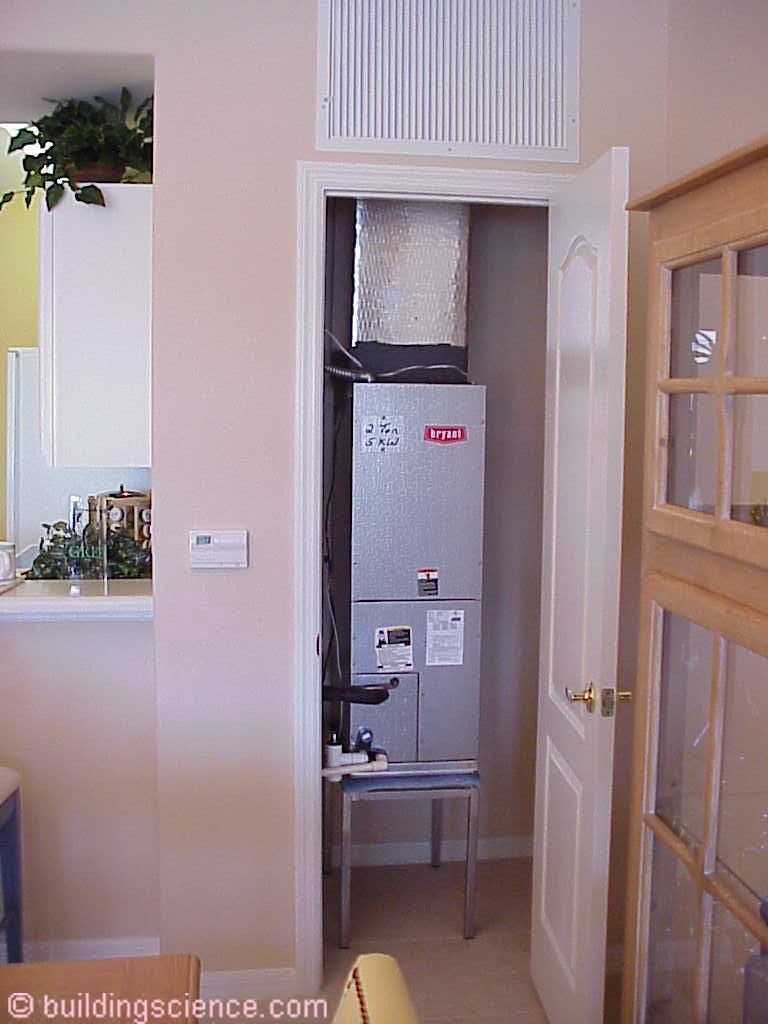
Photograph 6: Closet as Return Plenum – All the return air comes into the closet through the large transfer grille above the door. The closet is the “mechanical closet”.
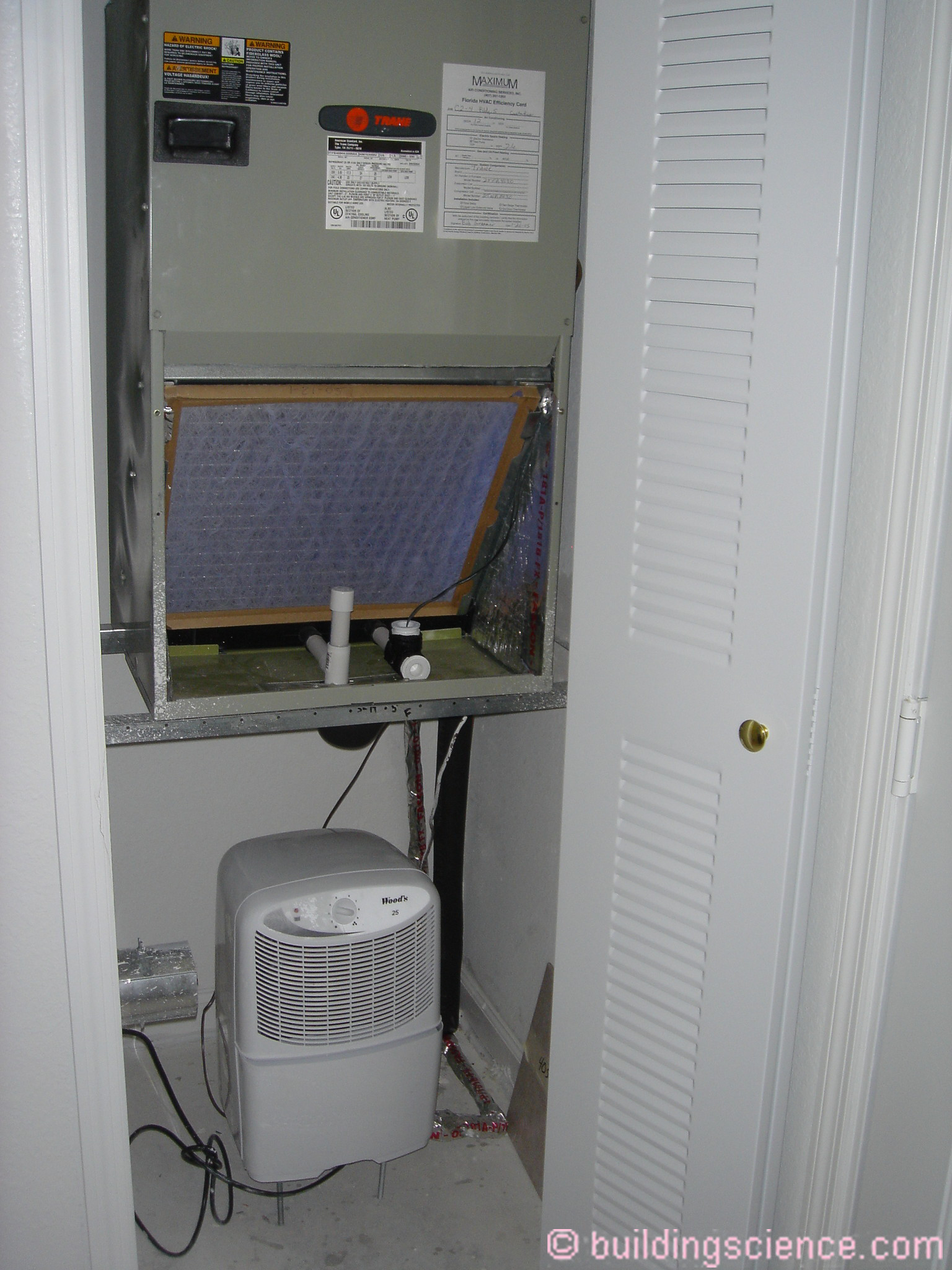
Photograph 7: More Closet Return Plenum – All the return air comes through the louvered bifold door. Note the “stand-alone” dehumidifier in the “return closet” providing part load humidity control.
Florida is pretty interesting with codes…and has a neat little wrinkle to the code prohibited return air grille issue. It is allowed…in Florida…to have a “closet ventilation system”. You can have a separate fan pulling air using ductwork from several closets and supplying this air to a common area. You can’t have your air conditioner air handler do this…but you can have a separate fan and separate ductwork to do this. It is an elegant4 some say “sleazy” way to get around the code…that will work everywhere.
Now, to me this is just all crazy. To fix crazy I tried to get a code change. It failed. The arguments against the change were pretty ridiculous and fundamentally wrong. The most compelling was that return should not come from closets because return air should not come from closets. Yup. That was it. The other was that closets are a source of contaminants and therefore return air should not come from closets. The first part is correct….the second part is not correct as the second part fixes the first part.
So, if was in charge, this is the change I would make to the code:
Return air openings.
Return air shall not be taken from a closet, bathroom, toilet room, kitchen, garage, boiler room, furnace room or unconditioned attic.
Exceptions:
Taking return air from a closet is not prohibited where such return air taken from closets shall serve only the closet and may be taken from closets that have no dedicated supply duct. Where return air is taken from a closet smaller than 30 ft2 (2.8 m2) the return air shall be no more than 30 cfm (15 l/s), shall serve only the closet, and shall not require a dedicated supply duct. Where return air is taken from a closet smaller than 30 ft2 (2.8 m2) the closet door shall be undercut a minimum of 1.5 inches (38 mm) or the closet shall include a louvered door or transfer grille with a minimum net free area of 30 inch2 (194 cm2).
Reason
Mold growth is now common in closets due to higher interior moisture loads and less heat gain in closets. Allowing a limited amount of return air provides a means of controlling closet moisture levels. Providing supply air to a closet exacerbates the problem by making closet surfaces colder.
OK, parting shot at codes….codes are no longer just technical documents…they have also become political documents. The code process is now also political and not just technical. At times it seems dominated by lobbyists, consultants, special interest groups and manufacturers who use the code process to promote specific agendas, limit competition to require their products to be used or both…while trying to save the world. Still trying to understand the politics of return air from closets. Pretty sure that the Chamber of Commerce or AARP are not involved. And, yes, I am a “consultant”…I put the “con” into “consulting”….
Reference:
The Healthy House – John Bower, 1989, Healthy House Institute, Boise, ID.
Footnotes:
1 Way back when…before I was an engineer…I was a young builder. The local building departments where I was building…Ontario, Canada…adopted me and taught me things…like how to build houses that actually worked. The inspectors would come out and say things like “Ah, young Joseph, I see you are about to install windows…let me tell you a little bit about flashing…” and…”When you insulate the attic you need to know about ice dams…it snows a lot around here…” Building officials were friends and allies not enemies…they still are today…you just need to talk to them more… The code making process is broken, not the building departments…that is another story for another day…
2 When I typically lost the louvered door argument back in the day…I would have a light installed in the closet and screw in a 100 watt bulb…then I would tell the folks to leave the light on…mold only grows in the dark….
3 There are lots of engineering designs that are “tasteful” and have “amazingly beautiful looks and style”…tell me that Reginald Mitchell didn’t have style when he designed the Supermarine Spitfire or Kelly Johnson didn’t have style when he designed the SR-71 Blackbird or John Roebling didn’t have style when he designed the Brooklyn Bridge…
4 Thank you big time Oscar Calleja of Engineered Air…you made it happen in Florida and we all owe you.
